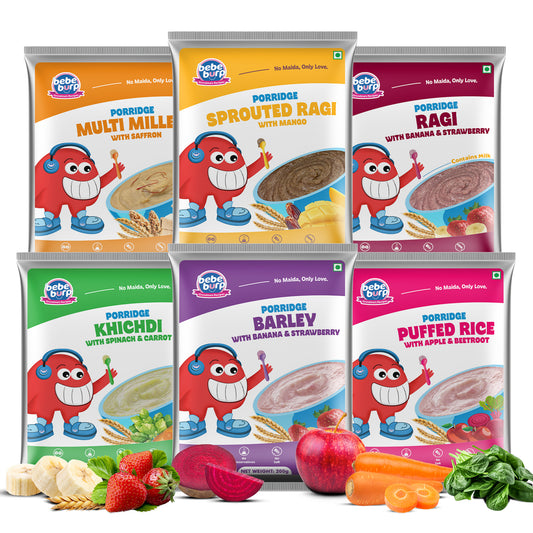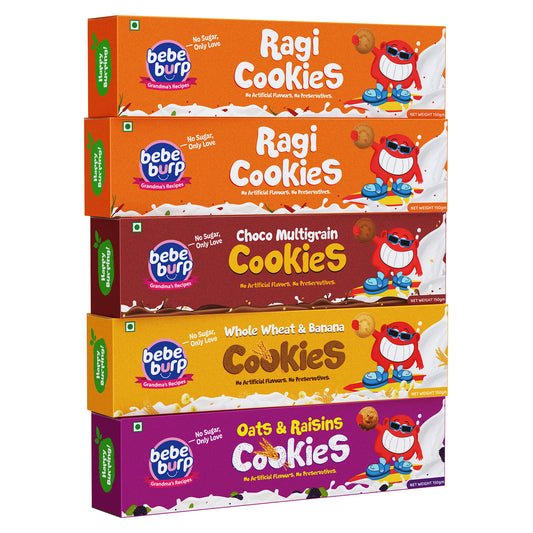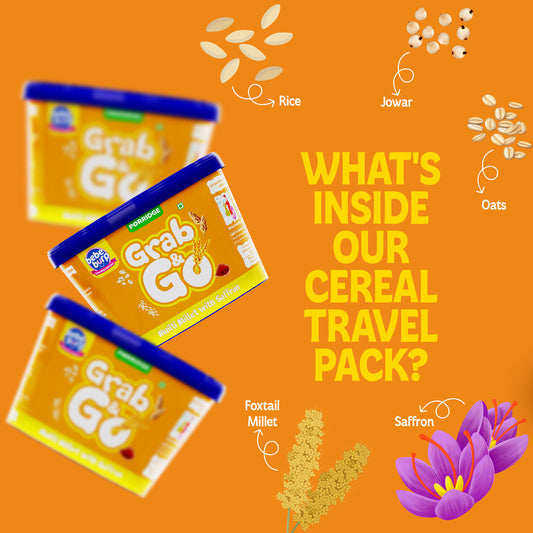Millet is a small, traditional, gluten-free Indian grain that has been used in Indian kitchens for generations.
Iron, calcium, fiber, and protein are some of the most important nutrients in millet.
These nutrients are easily digestible, making millets a great choice for a baby’s delicate stomach as a first food.
From Ragi (finger millet) to Foxtail, Little, and Kodo Millet—every cup is packed with goodness!
What Are Millets and Their Historical Significance
The millets are traditional grains that have been grown for 5,000+ years, particularly in Asia and African regions.
Since the time grandparents were children in Indian households, these small-seeded grasses were more common and replaced rice and wheat.
Family members from the past ate only grains, Ragi, Bajra and Jowar Supported Elders.
Even in dry areas, they prefer to grow eco-friendly sustainable millets that offer low costs and fast returns.
Millets were commonly used as an ingredient in traditional kitchens across India to prepare porridge and flatbreads; they were children's food.
These days, these grains are back in trend as people are becoming aware of the nutrient-rich health benefits and all that they can do.
Nutritional Benefits of Millets for Babies

1. Rich in Calcium — Helps make bones and teeth strong
Examples of good plant-based calcium options include foods like Ragi (a millet).
This helps build strong bones and teeth for your little one as they grow during the first few months of life.
2. High in Iron – Helps Prevent Anemia
Blood and Brain Development – Extra Iron Needed
Ragi and Barnyard Millet have plenty of natural iron.
This helps make healthy hemoglobin (a blood protein that carries oxygen) and supports brain growth.
3. Rich in Fiber – Helps Keep the Tummy Happy
The natural fiber in millets stops constipation and helps with smooth digestion.
This is especially important when babies are just starting solids.
4. Protein-Rich – Supports Growth and Muscle Development
Your baby needs plant-based protein like that found in millets for growth, tissue repair, and muscle development.
5. Rich in with Vitamins and Minories
B vitamins (B1, B2 and B3), all found in millets and magnesium, phosphorus, zinc: minerals that are important for brain health, boosting energy levels as well supporting immune health.
6. Great Carbs – Long-Lasting Energy
Unlike refined grains, millets provide energy that lasts longer.
They don’t cause sudden sugar highs, so your baby stays full and active for a longer time.
When Can Babies Start Eating Millet?
So when can you toss millet into a baby's food lineup? Around 6 months right when solids start.
But don’t go fast. Keep it simple: soft millet porridge only.
No salt, no sugar, no honey (save that for later).
And of course, check in with your baby’s doc first. Safety first, always.
7 Types of Millets Ideal for Babies
Millets are available in many varieties and are highly beneficial to the health of babies. They are tender for different stages of growth, easy to digest, and immensely nutritious.
1. Finger Millet (Ragi)

- Ragi is a rich source of calcium and it should be included in your daily diet to have strong bones and teeth.
- And it is high in the iron and amino acids important for growing bodies.
- smooth in texture and is often the first millet introduced during weaning due to its easy digestibility.
2. Pearl Millet (Bajra)

- Bajra is a good source of iron and fiber.
- Hemoglobin levels increase, digestion gets better Its texture is a little coarser and works well for 8-month-old and older babies when cooked as a smoothie (khichdi).
3. Foxtail Millet (Thinai/Kangni)

- Foxtail millet is rich in good carbs and B vitamins.
- It boosts energy, helps your body use food for energy (metabolism), and keeps the brain healthy.
- Its mild, nut-like taste makes it a great choice for baby food around 7 months of age.
4. Little Millet (Samai)

- Little Millet is a mild millet with fiber that’s good for babies with tummy issues.
- It’s easy to digest and makes a great choice for early weaning, especially for babies 6 months and older.
5. Barnyard Millet (Kuthiraivali/Sanwa)

- Barnyard millet has fewer calories but is high in iron.
- It’s great for babies who need lighter meals during sickness or teething.
- It’s easy to digest and often recommended for babies with allergies or sensitive tummies.
6. Kodo Millet (Varagu)

- Kodo millet is known for its antioxidant and reduces swelling and irritation properties.
- Supports brain and nerve development, good for baby body soothing as well.
- Slightly chewy texture, perfect for older babies (8 months and up).
7. Sorghum (Jowar)

- Jowar is a creamy and healthy millet that is packed with fiber, iron and loads of antioxidants.
- Promotes digestion and helps boost energy babies.
- Since it is slightly grainy and suitable are well cooked forms such as porridges or dosas only after 8 months after.
How to Introduce Millets to Your Baby - Age-by-Age Guide

With a baby, you can begin with one milled at a time and see the baby's response along with testing for allergies and digestion issues. Manage the texture from liquid to soft solids as the child grows.
6 to 8 Months – Start Soft and Simple
- Start with a single millet porridge (like Ragi porridge).
- If not using water, breast milk, or formula, cook it until soft.
- Do not add salt, sugar, or milk yet. Use only one type of millet at a time so you can easily spot any allergies.
8 to 10 Months – Time to Mix and Explore
- You can now tell your kids to try Little Millet, Foxtail Millet, and Barnyard Millet.
- Serve them with soft rice dishes or vegetable mash.
- You can also introduce a mix of two grains for variety.
10 to 12 Months – Add More Textures
- Babies can now take more solid foods and mixtures.
- to make soft idlis or dosas or upma you can use kodo millet, jowar, or pearl millet.
- Add a bit of ghee in the form of small pieces for healthy fats.
12 Months and Up – Variety and Balanced Meals
- Most types of millet are safe for babies at this age.
- Include millets in a mix of balanced meals with lentils, vegetables, and healthy fats.
- You can try dishes like millet flatbread (roti), rice dishes (pongal), or baked millet snacks.
- Slowly reduce purees and help your baby learn to chew.
5 Simple Millet Recipes for Babies
These recipes do require taking the proper care health wise, but they are straightforward to prepare. When cooking, pay attention to your little one's age alongside their digestion needs.
1. Millet Porridge (6+ months)
Ingredients:
- 2 tbsp foxtail millet or little millet (washed and soaked)
- 1 cup water
- A pinch of cardamom
- Optional: mashed banana or apple puree
How to Make:
- Pressure cook millet with water for 3–4 whistles.
- Mash it well or blend if needed.
- Add cardamom for a sweet aroma.
- Mix in fruit puree for added taste.
2. Ragi Banana Pancakes (8+ months)
Ingredients:
- 2 tbsp ragi flour (finger millet)
- 1 ripe banana, mashed
- 1 tsp ghee
- Water or milk to adjust consistency
How to Make:
-
Mix ragi flour, mashed banana, and water/milk into a batter.
-
Heat a pan with a little ghee and cook small pancakes on both sides.
-
Cool slightly and serve warm.
3. Multi-Millet Khichdi (9+ months)
Ingredients:
- 2 tbsp mixed millets
- 1 tbsp moong dal
- 1 small carrot (chopped)
- 1/4 tsp cumin seeds
- A drop of ghee
How to Make:
- Rinse and soak millets and dal for 30 mins.
- Cook all ingredients with water in a pressure cooker (3 whistles).
- Mash and serve with a little ghee on top.
4. Millet Apple Porridge (7+ months)
Ingredients:
- 2 tbsp kodo millet
- 1/2 apple, peeled and grated
- Water or breast milk/formula
- A pinch of cinnamon (optional)
How to Make:
- Cook millet in water until soft.
- Add grated apple and cook for 2–3 minutes.
- Mash or blend as needed. Add cinnamon if desired.
5. Ragi Malt (6+ months)
Ingredients:
- 1 tbsp sprouted ragi powder
- 1 cup water
- A pinch of cardamom
- Optional: jaggery or date powder for babies over 8 months
How to Make:
- Mix ragi powder with water to make a smooth paste.
- Cook on low flame till it thickens.
- Add sweetener if the baby is ready for it.
Ragi vs. Other Millets: A Comparative Analysis for Baby Nutrition
Ragi is one of the most used millets for babies. Let’s see how it compares with other millets.
Ragi vs Bajra - Finger Millet vs Pearl Millet
 Ragi vs Thinai/Kangni - Finger Millet vs Foxtail Millet
Ragi vs Thinai/Kangni - Finger Millet vs Foxtail Millet

Ragi vs samai - Finger Millet vs Little Millet

Ragi vs Kuthiraivali/Sanwa - Finger Millet vs Barnyard Millet

Ragi vs Varagu - Finger Millet vs Kodo Millet

Ragi vs Jowar - Finger Millet vs Sorghum

Precautions When Introducing Millets to Babies
- Introduce one millet at a time to check for allergies.
- Start with a small portion.
- Salt, sugar, spices ( don't add any) at the beginning.
- Check the texture: make sure it is smooth and gentle on their gums and teeth
- Check for allergies: Consult your pediatrician if your baby has health issues or common allergies.
FAQs About Millets for Babies
Can I give my baby millets daily? Yes, just rotate between different types for variety and balance.
Are millets gluten-free? Yes, they are naturally gluten-free and suitable for babies with gluten sensitivity.
Do millets cause constipation? No, in fact, the high fiber content in millets usually helps relieve constipation.
Can I mix millets with fruits or vegetables? Absolutely. Mixing with fruits or veggies makes millet more nutritious and palatable.
Conclusion
Millets stand out for being healthy food options for babies. They strengthen, help digestion, support smooth growth, and have a lot of other benefits! There are multiple types enabling you to tailor meals to their age and needs. This will help develop good habits from an early age.








